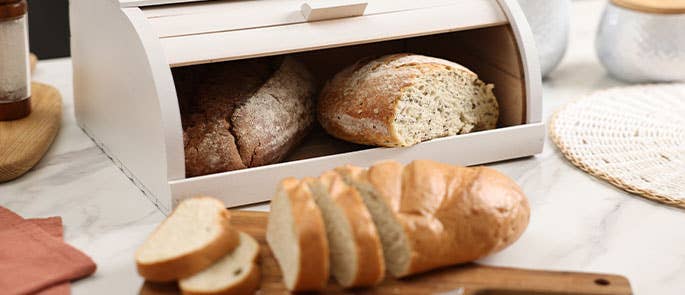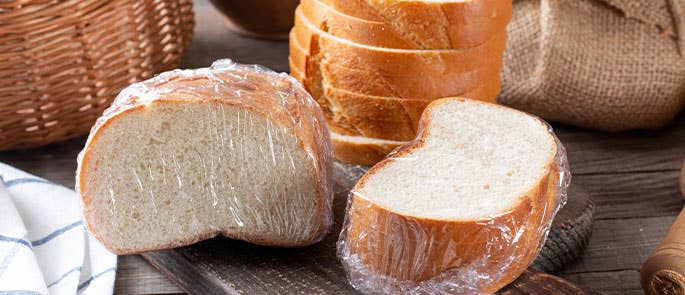How to Store Bread
Bread is one of the top five most wasted foods in the UK and it’s estimated that approximately 900,000 tonnes of bread are wasted each year! One of the best ways to reduce this food wastage is by knowing how to store bread correctly. Storing bread properly helps to keep it fresher for longer and ensures that you have as much time as possible to enjoy that most delicious of carbs. It might sound obvious but different types of bread have different needs, and what may work for a nice loaf of sourdough may well not work for a classic loaf of Hovis. In this article, we will explore the different ways to store bread and how this can impact its longevity.

How Long Does Bread Last?
How long bread will last depends on three main factors:
- Type – Certain types of bread will spoil quicker than others. Typically fresh bread such as homemade bread or bread from a bakery will last about 2 – 3 days before it spoils. Comparatively, bread bought from the supermarket is intended to last longer and typically lasts about one week before it spoils. Certain types of bread naturally last longer without the addition of preservatives such as sourdough bread or seeded breads. This is because they contain lactic acid which can slow down the staling process and inhibit mould growth. Nevertheless, fresh bread typically does not last as long as bread from the supermarket.
- Storage – The way in which you store bread can greatly impact its longevity. The different storage methods for bread will be explored in more detail later in the article, however, something as simple as storing bread in a bread bin rather than leaving it on the side, can greatly increase the life span of most bread.
- Climate – The external environment can also impact how long bread will last. If you live in a dryer climate then bread is likely to become stale more quickly. Comparatively, if you live in a more humid climate it is likely to become mouldy more quickly.

Does Bread Last Longer in the Fridge?
It’s that age-old question, does bread need to be refrigerated? The short answer is no, you don’t have to keep bread in the fridge. Moreover, the Federation of Bakers advises against storing bread in the fridge, except in very hot weather, as the average temperature of a fridge is 5°C and this is the temperature at which bread stales most quickly.
Bread that is stored in the fridge can stay fresher for longer, however it won’t exponentially extend the shelf life of bread. Moreover, the type of bread can greatly impact how bread will cope with being stored in the fridge. For example, soft breads can easily be stored in the fridge as they will not lose any crispiness from being kept in a more moist environment. However, the texture of other types of bread can be greatly impacted by being stored in the fridge. For example, oils and fats used to make certain types of bread such as brioche can react quickly to cold temperatures.
Whilst storing bread in the fridge can help to keep it fresher for a bit longer, it can also cause it to go stale quicker. This is due to a process called retrogradation. Retrogradation occurs when starch molecules crystallise as bread cools. This draws moisture out of the bread, which helps to keep the bread mould-free, but also leaves the bread dry and stale.
If you choose to keep your bread in the fridge then it’s important that you store it properly. The best way to store bread in the fridge is in its original packaging or in an airtight container.

Can you Freeze Bread?
Yes, you can freeze bread. Freezing bread preserves it the longest and so is often the best option if you know you want your bread to last longer than a few days. When freezing bread it’s a good idea to double wrap it in cling film and foil; cling film helps to prevent bread from drying out and absorbing any odours or flavours from other items in the freezer, whilst foil helps to prevent freezer burn and stops ice crystals from forming.
It’s advisable to pre-slice bread before you freeze it as this ensures that you don’t defrost more than you actually need. Shop-bought bread will already be sliced and this makes it easier to remove individual slices as and when needed. When freezing homemade bread or unsliced bread from the bakery, it can be helpful to pre-slice it before wrapping it and freezing it.
Shop-bought bread typically lasts longer in the freezer as it has added preservatives to help it last longer. As such, shop-bought bread will typically last 4-6 months in the freezer. Comparatively, homemade bread or bread from a bakery will not last as long as it doesn’t contain preservatives. Homemade or bakery bread will typically last 2-3 months in the freezer.
You can learn more about how long you can freeze your food here: Can I Freeze This & For How Long?

How to Defrost Bread
Defrosting bread is an easy process, and many modern toasters have a setting specifically for frozen bread. To defrost bread, simply remove all wrapping, such as clingfilm and/or foil, and leave it to thaw on the kitchen counter until it is soft. Alternatively, frozen bread can go straight into the toaster and be heated as normal. You may need to engage a frozen setting or increase the temperature slightly to ensure that the bread is properly thawed.
If defrosting unsliced bread, place the whole loaf into the oven with a sprinkle of water. How long it will take to thaw depends on the size of the loaf, however low and slow is typically the best approach in order to ensure the inside of the bread stays soft and the inside nice and crusty.
Avoid refreezing defrosted bread as this can spoil the texture.
To learn more about defrosting your food, take a look at our article: How to Defrost Food Safely
How to Store Bread and How to Keep Bread Fresh
Below, you will find some handy tips on the best ways to store bread to keep it fresher for longer.
- Store bread in a bread bin as it provides a cool and dry environment that helps to keep bread fresh.
- Avoid storing bread in the fridge as this can cause it to become stale quickly.
- Where possible, keep bread in its original packaging as it is designed to retain moisture and freshness.
- If you don’t have the original packaging, store bread in a paper bag.
- For short-term storage, store bread at room temperature, away from direct sunlight.
- For long-term storage, freeze bread that is pre-sliced and well-wrapped.
- The type of bread can impact how long it stays fresh; bread with a higher fat content, such as brioche or focaccia, tends to go stale more slowly.
Bread is a household staple enjoyed across the country, whether it be for breakfast, lunch or dinner. Keeping bread fresh ensures that it can be enjoyed for longer and that less food is wasted. A simple bread bin can help to keep bread fresh for short-term storage, whilst freezing bread is the perfect option for long-term storage. Following the tips listed above will help to keep your bread fresh and enjoyable to eat for longer.
Further Resources:
- Food Hygiene Courses
- How to Store a Cake
- How to Store Cheese
- Safe Temperatures for Food Storage: A Free Guide to Cooling and Chilling Times
- How Long Does Food Last in the Freezer? A Storage Guide
- How to Store Food in the Freezer







